Review: Skoda Roomster
Skoda’s aptly-named Roomster is one of the pioneers of the B-segment MPV, but in a fast-moving marketplace, it has stood still for quite some time.
That begs the question, with such advancement all around it, can the dinky Roomster still cut the mustard?
The menace of the years
On the outside, there can be little doubt that the years haven’t been kind to the Roomster. The front end is stolen from the outgoing Fabia – itself now out-dated – and there’s a definite sense that the car was penned by a different designer from the B-pillar backwards.

Though the Scout bodykit on our test car brings it all together quite well, the big rear windows don’t marry up with the Lancia Stratos-esque front windows and the roof has a hint of the step found on a 1996 Land Rover Discovery.
Maybe that mismatch of designs is no surprise though, given that the Roomster was designed to be two cars in one.
Split personality
From the driving seat, your first impression is not one of space, but of familiarity. The ‘driving room’ has been tasked with feeling like the cockpit of any other hatchback, so the front seats feel exactly like those of the outgoing Fabia, although the driving position feels a little more elevated.
However, sitting in the back seats, or the ‘lounge room’, the big rear windows come into their own, letting in bags of light and making an already capacious passenger area feel even more airy.
The boot is pretty enormous too, with 480 litres of luggage capacity with the seats up.
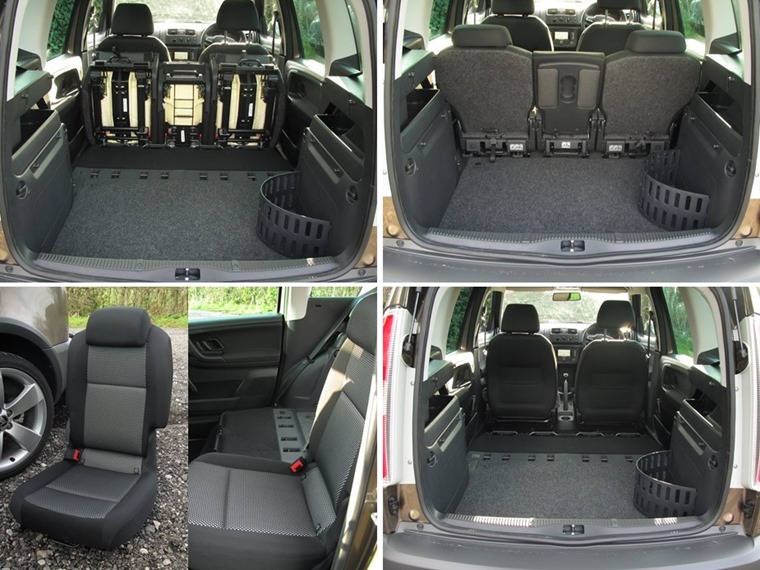
It’s not just the figures which impress though. The ‘Varioflex’ rear seating is almost infinitely flexible, to the point where any of the three seats can be completely removed with relative ease, although they are on the heavy side.
Heft them out and you’ll be left with a 1,810-litre luggage space – just 98 litres smaller than the Ford Transit Courier panel van’s load bay.
The outside two seats slide forwards and backwards to provide an extra few inches of load bed or legroom, depending on requirements, while the central seat can be tilted forward to create a ski hatch and an armrest.
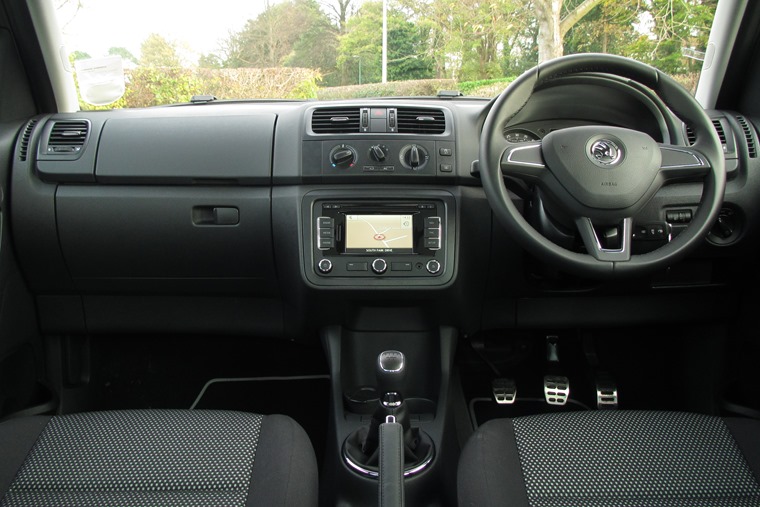
While the Roomster’s interior may be very cleverly thought out, it does have a couple of issues.
For a kick-off, the whole cabin looks a bit outdated and quite dull, with unbroken swathes of dark plastic, tiny infotainment controls and nothing to break the monotony. The plastics aren’t of great quality either, though at least everything does seem well bolted together.
Falls short
The cabin’s sub-standard styling wouldn’t be such a problem were the car cheap and/or well equipped, but sadly it falls short on those fronts too.
Our test car, which came in Scout trim, came with electric mirrors, manual air conditioning, the Scout bodykit and tinted windows as standard. Its best features though, like the 17in alloys, sat nav, Bluetooth connectivity and panoramic glass roof, were all present on an options list which amounted to more than £2,000.
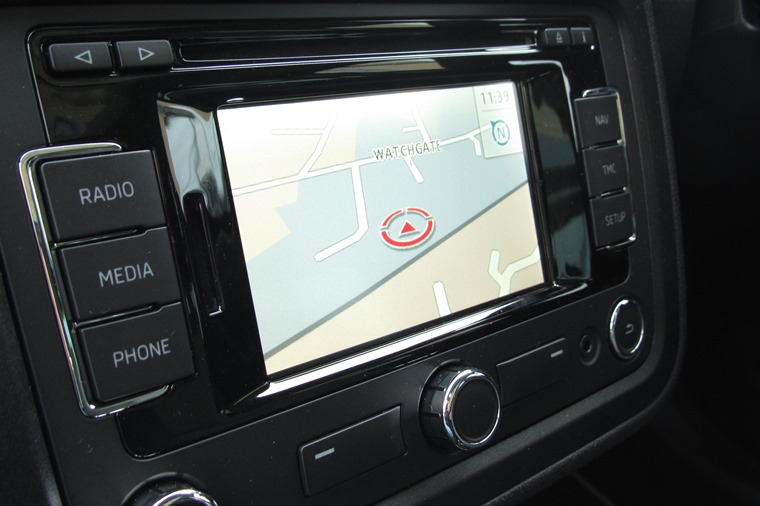
As a result, our car came with an on-the-road price of £18,200.
Of course, the basic Roomster S comes in at £12,105, which is a much more competitive price point, but the kit list is sparse at best. Arguably the most desirable feature is the 3.5mm AUX socket built into the radio, followed by the tinted glass and electric front windows, but that’s about as exciting as it gets.
More competitive
Thankfully for the Roomster, the engine range is more competitive.
Three petrol engines and three diesels are available, with outputs ranging from 68bhp to 104bhp.
Of the six engines, the most efficient is the 74bhp 1.2-litre diesel offered only on the GreenLine model. Returning 67.3mpg, it’s more efficient than even the greenest Hyundai ix20, but the 94bhp Ford Focus B-Max diesel is a little more frugal, managing just over 70mpg.
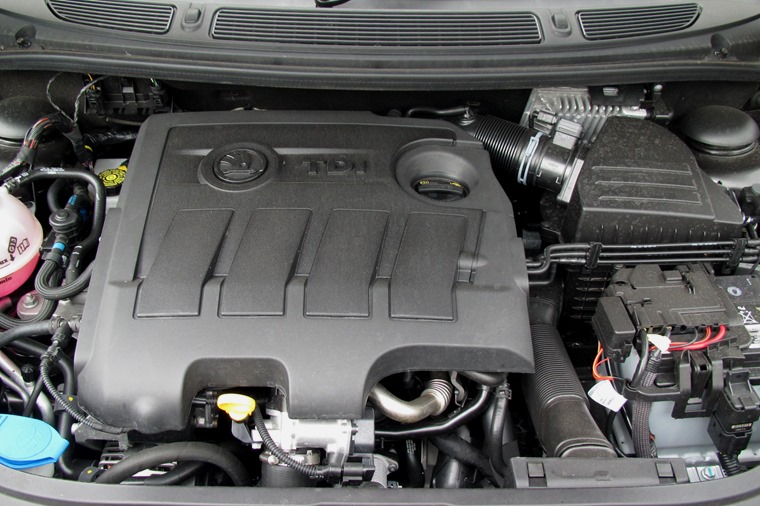
Despite the efficiency, the GreenLine Rapid is a little more polluting than the competition, emitting CO2 at a rate of 109g/km to put it in the £20 a year VED band and incur 17% BIK tax. The aforementioned diesel B-Max, meanwhile, is in the same VED band but cuts BIK to 16%.
Our Roomster Scout came with the larger and more powerful 1.6-litre, 104bhp diesel, which had a bit of punch but not enough for the biggest diesel in the range. A 0-62mph time of 11.5 seconds is respectable but unremarkable, although with four people on board the little Roomster really feels blunted.
That said, this is no performance car, so economy is a far more important consideration. Fortunately, the Roomster fares slightly better in this department, with a quoted 60.1mpg and CO2 emissions of 124g/km, equating to £110 a year in VED and 20% BIK – not bad for a car without stop/start.
Tuned for comfort
Skoda says the Roomster was designed to drive like a hatchback, and despite the swollen rear end, it performs admirably.
There’s plenty of grip and the steering is precise and feelsome – one clear advantage of an old-school power steering system over modern electro-mechanical setups.
As you’d expect from a car which is the best part of 20cm taller than the new Fabia, there’s quite a lot of body roll, but though the extra bulk and weight makes its presence felt, it doesn’t completely spoil the driving experience.

It is obvious, however, that the Skoda’s suspension has been tuned more for comfort than handling, and it flattens out broken road surfaces with minimum fuss, despite the test car’s larger-than-standard alloys.
Disappointingly though, refinement is not the Roomster’s forte. The cabin lets in slightly too much of the diesel engine’s rumble and the tyre roar, but for such an ungainly car, wind noise is remarkable by its absence.
It’s also a pity that the Scout model we drove doesn’t come with four-wheel drive, because the car would be well suited to a ‘soft-roader’ variant.
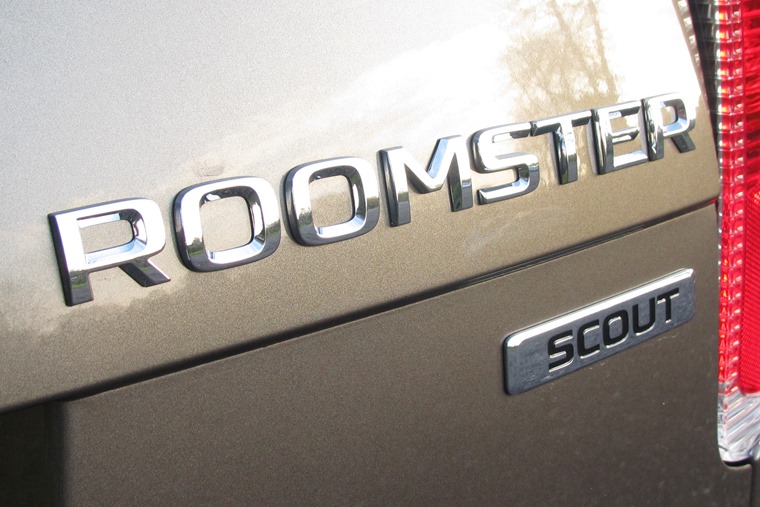
The verdict
The Roomster has always been a competent car which fulfils its remit of offering a hatchback driving experience with the practicality and space of a van, but the opposition has caught up and the Ford B-Max is better looking and more economical.
Fortunately, Skoda doesn’t need to do much to fix its pioneering mini MPV. Simply facelifting the body and interior to bring it in line with the new Fabia and Octavia would do nicely.
Skoda Roomster at a glance
For:
+ Van-like practicality
+ Delivers on hatchback driving experience
+ Scout bodykit improves looks dramatically
Against:
- Mismatched styling
- Dull cabin with hard plastics
- Not quite as economical as the B-Max
Vital stats
Length: 4,214mm
Width: 1,684mm (1,897 inc. mirrors)
Height: 1,607mm
Wheelbase: 2,621mm
Kerb weight: 1,125kg – 1,247kg
Engines: 1.2 12V 69PS, 1.2 TSI 86PS, 1.2 TSI 105PS (also auto), 1.2 TDI 75PS, 1.6 TDI 90PS, 1.6 TDI 105PS
Trims: S - £12,105+; SE - £13,575+; Scout - £14,685+; GreenLine II - £16,325+
Cheapest: 1.2 12V S - £12,105
Priciest: GreenLine II 1.2 TDI - £16,325
Cleanest: GreenLine II 1.2 TDI – 67.3mpg, 109g/km
Fastest: 1.2 TSI 105 – 10.9s, 114mph
Rivals: Ford B-Max, Hyundai ix20, Citroen C3 Picasso, Nissan Note